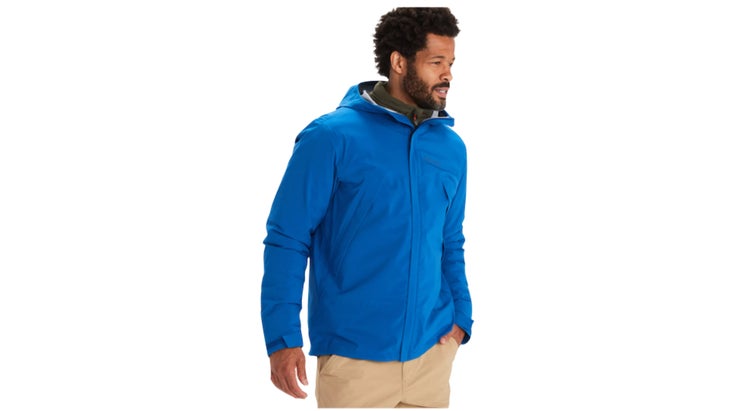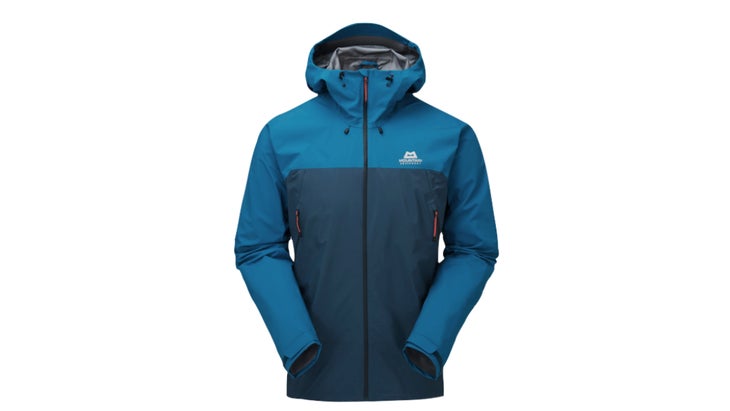Products You May Like
Get full access to Outside Learn, our online education hub featuring in-depth fitness, nutrition, and adventure courses and more than 2,000 instructional videos when you sign up for Outside+
Sign up for Outside+ today.
Picture Organic Abstral 2.5L ($165)

Most Versatile Hard Shell
If you’re looking for a solid jacket for most conditions, at less than half the cost of the competition, this is your shell. From Appalachian drizzles to Rocky Mountain downpours, the Abstral kept us protected. It offers the full suite of features, including an adjustable hem and cuffs, a helmet-compatible hood, and two zippered hand pockets, and it packs up to the size of a grapefruit in its stow pocket. The catch? The details aren’t as dialed as they are on more expensive shells. The zippers are finicky, the cuff-adjustment strips are uncomfortably stiff, and the hood struggles to stay up over a ponytail. The 2.5-layer construction kept us comfortable on a rainy run in Montana, but got steamy backpacking on steep stretches of Virginia’s Appalachian Trail in the sixties. But these are annoyances, not deal-breakers. You get enough stretch to move freely, and the polyester interior feels smooth, not sticky, on bare arms. As for eco cred, the Abstral’s polyester face fabric is 46 percent recycled, and the DWR is PFC-free. 13.8 oz (men’s S–XXL) / 10.5 oz (women’s XS–XL)
Goldwin Fast Shell Light ($290)

Most Breathable Hard Shell
Despite what ads tell you, no waterproof shell is completely breathable—blocking water requires some impediments to vapor transfer. The best jackets simply minimize that compromise. The Fast Shell Light does just that with Pertex’s new, air-permeable Shield Air fabric, which has a membrane made of randomly assorted nanofibers. The fibers crisscross each other, forming tiny pores that allow air to escape directly (unlike membranes that allow only moisture vapor to pass through, like Gore-Tex). It was the most breathable material we tested this year. That, plus the ultralight nylon face and lining fabrics, kept us from overheating, even on tough slogs. “While hiking a ridge in Gatineau Park with my toddler on my back in 40-degree weather, I was happy I could keep the elements off me without getting soggy inside,” said a Canadian tester. Still, we stayed dry in a three-hour downpour at Mont Tremblant National Park, helped by the hem, cuffs, and nonadjustable hood—not bad for a jacket that fits inside a coffee mug. Boo: no women’s version. 5.9 oz (men’s S–XL)
Mountain Hardwear Stretch Ozonic ($200)

Best All-Around Hard Shell
The Stretch Ozonic lives at the nexus of price, performance, durability, and light weight. Its three-way adjustable hood (not helmet-compatible) amply covers the head and zips over the chin, but is small enough to remain unobtrusive when not in use. You also get a chest pocket big enough for light gloves, plus two mesh-lined hand pockets and a cinchable hem and cuffs, all in a package that smushes down to the size of a large tomato. The 50-denier, 100 percent recycled polyester fabric has a PFC-free DWR and feels soft, not plasticky. One tester appreciated its stretchiness on a scrambly, brushy traverse from Lilian Lake to Ribbon Lake in the Canadian Rockies and found that it held up without a tear. And the 2.5-layer proprietary construction sheltered us from all-day rain on Pennsylvania’s Bucktail Path and wind-driven drizzle on the shores of Lake Erie. The moderate fit worked well with multiple layers underneath, and the longer cut of the sleeves and hem kept drips out while biking. 11.3 oz (women’s XS–XL) / 10.9 oz (men’s S–XXL)
Marmot Precip Pro 3L ($150)

Best Value Hard Shell
When the going got tough, this shell kept going, without hurting our wallets. One New Hampshire tester brushed its 75-denier polyester face through poky young evergreens, shouldered an ax, and sawed branches while doing trail work on Mount Moosilauke. “No signs of wear at all,” he said. “I’m confident wearing it for bushwhacking through thick brush.” Weather protection is equally bombproof. We stayed dry in full-day rains, thanks to an adjustable hood, effective storm flaps over the zippers, and a cinchable hem that turned back cold White Mountain winds. That toughness comes with a breathability tax. Marmot’s three-layer NanoPro material “felt a bit steamy on a drizzly, 60-degree trail run in Massachusetts’s Middlesex Fells Reservation,” said a tester. Though, pit zips do help. We loved the relaxed fit, which accommodates a puffy underneath, and the plentiful features, including smooth-running zippers, adjustable cuffs, and large chest pockets that swallow gloves. The whole package rolls down to the size of a water bottle. 14 oz (men’s S–XXL) / 13 oz (women’s XS–XL)
Adidas Terrex Agravic Pro Windweave ($170)

Lightest Soft Shell
This shell is about as close as you can get to an invisible wind-blocking force field. The Agravic Pro weighs as much as a couple of string cheeses and packs to tennis-ball size, yet it held its own against gusts up to 30 miles per hour. It was all that one tester needed to keep going comfortably when the wind kicked up halfway through a trail run in the Mount Baker-Snoqualmie National Forest. The shell’s woven material combines two different densities of nylon, with a more air-permeable weave on the torso, upper arms, and shoulders. The combo jettisoned our tester’s body heat on days into the forties, though we felt clammier when temps and humidity climbed. The DWR kept one Sedona, Arizona, mountain biker dry in a 15-minute shower, but we probably wouldn’t push it beyond that. Adidas somehow managed to cram a few features into 2.7 ounces, too, like a head-hugging hood and asymmetrical (read: no chin rub) half-length chest zipper that’s great for venting. The lightweight, 10- and 30-denier fabric needs TLC, but it stood up to daypack straps and brushes against piñon branches without visible wear. 2.5 oz (women’s XS–XL) / 2.7 oz (men’s S–XXL)
Rab Windveil Pull-On ($100)

Most Breathable Soft Shell
For highly aerobic days spent trail running, mountain biking, and steep hiking, we reached for this überlight, super-stretchy shell. “It prevented me from getting swampy, protected me from the occasional drizzle, and kept the wind bearable on the cooler summit,” reported one tester after a 16-mile, 50-degree hike outside Jackson, Wyoming. Polyester mesh jersey fabric on the upper back, sides, and armpits proved highly effective at moving heat even under backpacks and running vests. That’s helped by the deep, half-zip front, which has a snap closure that keeps the shell’s chest panels from flapping around in the breeze when you have it unzipped for ventilation. The Windveil’s trim, body-hugging cut moved with us and fit best over just a T-shirt or base layer, and it packs down to peach size. Trade-off: there’s no hood, but you get an inner pocket that fits a smartphone or headlamp, a cinchable hem, and half-elastic cuffs that are cut long over the hands for extra protection against the elements. The 20-denier nylon fabric on the main body keeps weight down, yet we suffered no snags when running on overgrown trails. 4.1 oz (men’s S–XXL) / 3.5 oz (women’s S–XL)
Montane Krypton Hoodie ($155)

Warmest Soft Shell
Cozy doesn’t often come to mind when you think of shells, but that’s exactly what testers said about this extra-comfortable jacket. The polyester-elastane fabric is woven to be smooth on the outside and brushed on the inside, and it kept us warm into the low forties on day hikes, bike rides, belay sessions, and camping trips. “The fuzzy lining and warm, fleecy pockets felt so inviting on early-morning hikes,” said a tester. “And the hood was so cozy to pull up while camping in Washington’s Twanoh State Park.” Trade-off: all that fluff means it’s heavy, bulky (packing down a little smaller than a football), and not breathable enough for intense exercise. But it’s perfect for mellow activities in cool or variable weather. The DWR-treated fabric shed drizzle for 45 minutes along Washington’s Hood Canal and blocked gusts up to 30 miles per hour at Snoqualmie Pass. We particularly liked how the helmet-compatible hood’s wired brim kept rain out of our eyes. You also get two hand pockets, a chest pocket, and a high collar that seals out breezes. The cut is trim and short, so consider sizing up to wear it with more than a base layer. 15.9 oz (women’s XS–XL) / 18.9 oz (men’s S–XXL)
Mountain Equipment Firefox ($475)

Best Alpine Hard Shell
Whether we were perched on Liberty Bell in the North Cascades, descending from the Grand Teton in a thunderstorm, or hiking Alaska’s Eagle Peak in a deluge, we were always glad to have this shell. It proved impenetrable to precipitation, and it struck the ideal balance of mobility, toughness, and packability for above-treeline exploits. The Firefox’s smart design features shine in the alpine: hand pockets sit above a harness and hipbelt, articulated sleeves and a longer-than-average hem let us reach freely without hiking it up, and the three-way-adjustable hood fits over streamlined helmets. Caveat: the hood was too small for one tester to belay comfortably, and the trim fit works best over a base layer and light midlayer. The 30-denier nylon face shrugged off granite scraping, and the latest Gore-Tex Active membrane (one of Gore’s lighter, more breathable offerings) plus 11-inch-long pit zips (on the men’s jacket) give above-average breathability. “Winds were gusting at 30 miles per hour with temps in the thirties as we left the saddle of the Grand Teton at 9,000 feet,” reported one tester. “Even then, this jacket kept me protected and comfortable.” 9.9 oz (women’s 8–16) / 11.6 oz (men’s S–XXL)
